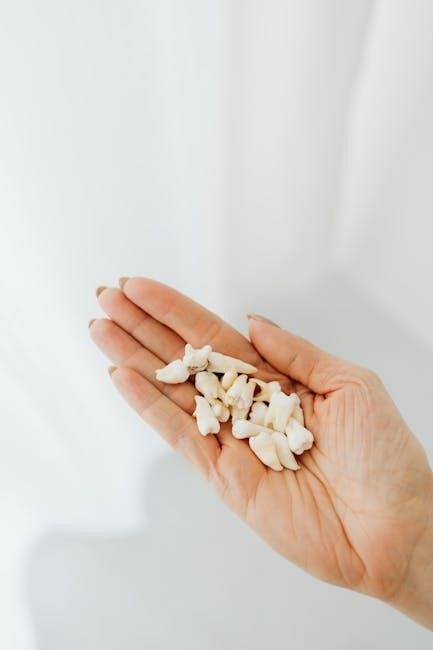Immediate Post-Operative Care
After tooth extraction, bite gauze firmly for 30-60 minutes to control bleeding. Avoid spitting, rinsing, or touching the surgical site. Apply firm pressure if bleeding persists.
- Avoid alcohol, carbonated drinks, and smoking for 24 hours.
- Keep fingers and tongue away from the extraction area.
- Rest and avoid strenuous activities to promote healing.
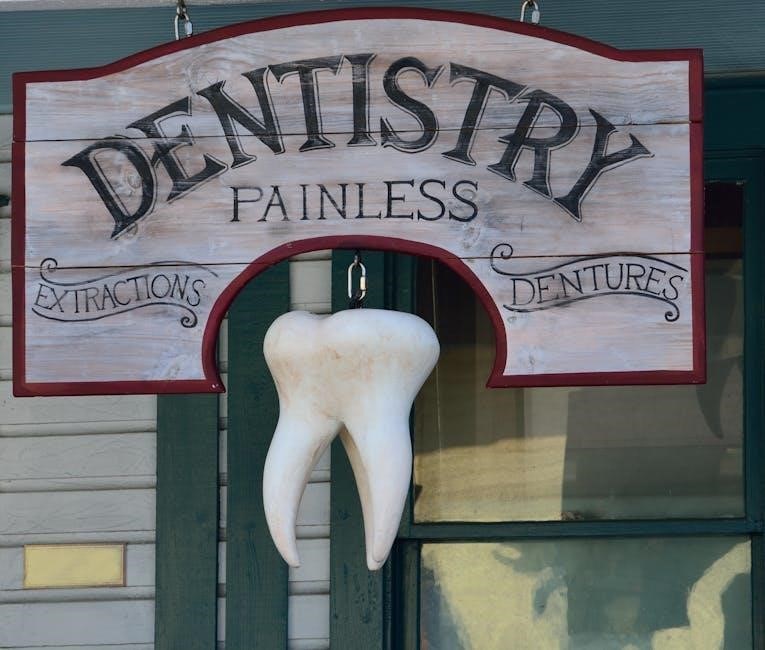
Bleeding Management
Some bleeding after tooth extraction is normal. Bite firmly on the gauze for 30-60 minutes to create a clot. If bleeding continues, apply firm pressure with fresh gauze for another hour. Avoid activities that may dislodge the clot, such as spitting, rinsing, or smoking. If bleeding persists or becomes heavy, contact your dentist immediately. Monitor for signs of excessive bleeding, such as soaking more than two gauzes in an hour. Keep your head elevated to reduce blood flow to the area. Avoid hot drinks or strenuous activities for 24 hours to minimize bleeding risks.
Gauze Usage and Pressure Application
Place gauze directly on the surgical site and bite firmly for 30-60 minutes to control bleeding. If bleeding continues, replace with fresh gauze and apply firm pressure for another hour. Ensure the gauze is secure to avoid dislodging the clot. Avoid chewing or moving the gauze unnecessarily. If bleeding persists despite these measures, contact your dentist. Proper gauze usage and pressure are crucial for promoting clot formation and minimizing bleeding risks during the initial healing phase.
Rest and Activity Restrictions
Rest is essential for the first 24 hours after extraction. Avoid strenuous activities, bending, or heavy lifting, as these can dislodge the clot. Limit physical exertion to prevent bleeding. Keep your head elevated while resting to reduce swelling. Avoid smoking or using tobacco products, as they can delay healing. Stay hydrated but avoid carbonated drinks. Light activities can resume gradually, but consult your dentist before returning to normal routines. Proper rest supports healing and minimizes complications, ensuring a smoother recovery process.

Dietary Recommendations
Stick to a soft diet, avoiding hot, spicy, or sharp foods. Stay hydrated with water or clear broths. Avoid alcohol and carbonated drinks for 24 hours.
- Opt for soft foods like yogurt, mashed potatoes, and scrambled eggs.
- Avoid chewing directly over the extraction site.
- Plan meals rich in nutrients to support healing.
Soft Food Options
After tooth extraction, opt for soft, non-irritating foods to minimize discomfort and promote healing. Choose foods like yogurt, mashed potatoes, scrambled eggs, and soft-cooked vegetables.
- Include soft fruits such as bananas or applesauce.
- Consider soups or broths for easy consumption.
- Avoid foods with sharp edges or hard textures.
- Opt for smooth, creamy foods like avocado or hummus.
These options are gentle on the surgical site and support recovery without causing irritation or discomfort.
Avoiding Hot or Spicy Foods
After tooth extraction, avoid hot or spicy foods to prevent discomfort and irritation. Hot foods can increase swelling and cause pain, while spicy foods may irritate the surgical site.
- Opt for cool or lukewarm meals during the initial healing phase.
- Steer clear of foods with high acidity or sharp flavors.
- Choose bland, soft foods to protect the extraction area.
This precaution helps ensure a smooth recovery and prevents complications at the surgical site.
Hydration Tips
Staying hydrated is crucial after tooth extraction to aid healing and prevent dry socket. Drink plenty of water, but avoid using a straw for 24 hours to prevent dislodging the clot.
- Opt for lukewarm or cool beverages to avoid irritating the surgical site.
- Clear broths or herbal teas can be soothing and hydrating.
- Avoid hot liquids, as they may cause discomfort or bleeding.
Proper hydration supports recovery and helps maintain overall health during the healing process.
Meal Planning for Recovery
Plan meals rich in soft, nutrient-dense foods to support healing after tooth extraction. Opt for foods like yogurt, scrambled eggs, and mashed potatoes to avoid chewing.
- Incorporate protein sources such as soft-cooked chicken or fish to aid tissue repair.
- Add vegetables like mashed carrots or zucchini for essential vitamins and minerals.
- Include whole grains like oatmeal or soft-cooked rice for sustained energy.
Avoid spicy, acidic, or sharp foods that may irritate the surgical site. Focus on balanced, easy-to-eat meals to promote a smooth recovery.
Pain Management
Manage discomfort with prescribed medications or over-the-counter pain relievers as directed. Monitor pain levels and adjust medication use to ensure comfort during recovery.
- Follow dosage instructions carefully to avoid complications.
- Notify your dentist if pain persists or worsens.
Prescribed Medications
Take prescribed medications as directed by your dentist to manage pain, inflammation, or infection. Antibiotics may be prescribed to prevent infection, while pain relievers help reduce discomfort. Always follow the recommended dosage and avoid sharing medications. If side effects occur, contact your dentist immediately. Do not mix medications with alcohol or tobacco, as this can hinder healing. Stay hydrated to aid absorption and effectiveness. If pain persists despite medication, notify your dentist for further guidance. Proper use of prescribed medications is crucial for a smooth and complication-free recovery.
- Complete the full course of antibiotics if prescribed.
- Avoid operating heavy machinery while on pain medication.
Over-the-Counter Pain Relief
Over-the-counter pain relievers like ibuprofen or acetaminophen can help manage mild to moderate discomfort after tooth extraction. Follow the recommended dosage on the label or as advised by your dentist. Ibuprofen reduces inflammation, while acetaminophen alleviates pain without inflammation relief. Avoid combining OTC medications with alcohol or tobacco, as this can slow healing. Do not exceed the maximum daily dose to prevent side effects. If pain persists despite OTC relief, consult your dentist for stronger options. Always read and follow the medication instructions carefully to ensure safe and effective use during recovery.
- Choose ibuprofen for inflammation-related pain.
- Opt for acetaminophen if NSAIDs are not suitable.
- Avoid operating heavy machinery while using pain relievers.
Managing Discomfort Levels
After tooth extraction, managing discomfort is crucial for a smooth recovery. Rest and avoid strenuous activities to prevent dislodging the blood clot. Apply ice to reduce swelling and ease pain. Stay hydrated with lukewarm water to promote healing. Avoid hot or spicy foods that may irritate the surgical site. Monitor your pain levels and adjust your medication as needed; If discomfort worsens, contact your dentist for guidance. Proper care ensures a comfortable and effective recovery process.
- Rest and avoid strenuous activities.
- Apply ice to reduce swelling.
- Stay hydrated with lukewarm water.
- Avoid hot or spicy foods.
- Monitor pain levels and adjust medication.
When to Contact Your Dentist
If you experience heavy bleeding, severe pain, or swelling that worsens, contact your dentist immediately. Fever, persistent bad taste, or loose stitches also require attention. If the extraction site develops a whitish tissue or signs of infection, seek professional care. Monitor healing progress and reach out if unusual symptoms arise. Timely communication ensures proper recovery and addresses potential complications early.
- Heavy or uncontrolled bleeding.
- Severe pain not relieved by medication.
- Fever or signs of infection.
- Swelling that worsens over time.
- Bad taste or loose stitches.
- Whitish tissue at the extraction site.

Oral Hygiene Practices
Maintain oral hygiene by avoiding rinsing or spitting for 24 hours. Gently brush around the surgical site with a soft toothbrush. Use dental floss carefully to prevent irritation.
- Avoid touching the extraction area with fingers or tongue.
- Keep the surgical site clean to promote healing.
Brushing Techniques
Use a soft toothbrush to gently clean teeth, avoiding the surgical site. Begin with light strokes around the area, gradually increasing as healing progresses. Avoid direct contact with the extraction site to prevent dislodging the clot. For the first few days, rinse with salt water before brushing to soften debris. Resume normal brushing when comfort allows, ensuring the surgical area remains clean. Avoid vigorous scrubbing, which could irritate the healing tissue. Maintain gentle, circular motions to remove plaque without causing discomfort or bleeding.
- Brush teeth twice daily with a soft-bristled toothbrush.
- Avoid using harsh toothpaste or abrasive products.
Rinsing with Salt Water
Rinsing with salt water helps keep the surgical site clean and promotes healing. Dissolve 1 teaspoon of salt in 8 ounces of warm water. Gently swish the solution around your mouth, focusing on the extraction area, for 30 seconds before spitting. Avoid vigorous rinsing or spitting, as this could dislodge the clot. Start rinsing 24 hours after surgery and continue 2-3 times daily for the first week. This practice reduces swelling, soothes irritation, and prevents infection. Salt water is a gentle alternative to mouthwash during the initial healing phase.
- Use warm, not hot, salt water to avoid discomfort.
- Rinse gently to protect the healing tissue.
Avoiding the Surgical Site
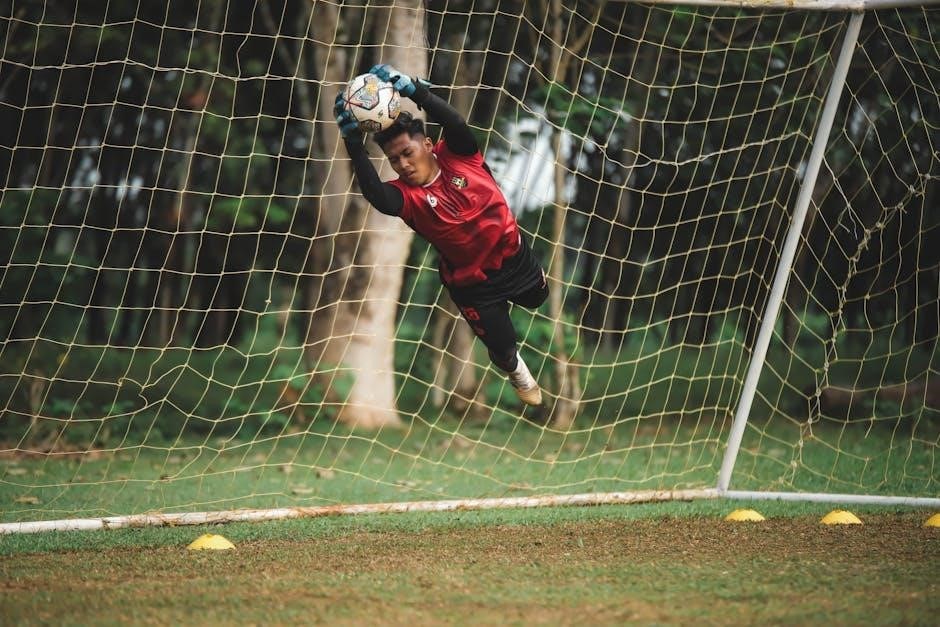
Keep your fingers, tongue, and other objects away from the extraction site to prevent irritation and dislodging the blood clot. Avoid rinsing or spitting forcefully, as this can disturb the healing area. Refrain from touching the site with your tongue or fingers, as this can introduce bacteria or cause discomfort. Let the area heal naturally without interference. This precaution helps prevent infection, promotes clot formation, and supports proper tissue repair. Maintaining distance from the surgical site ensures a smoother recovery and reduces the risk of complications.
- Do not probe or examine the site with utensils or fingers.
- Let food and liquids pass gently around the area.
Dental Floss Usage
Gently floss around the surgical site to maintain oral hygiene without disturbing the extraction area. Use unflavored, unwaxed floss to avoid irritating the gums. Avoid flossing directly over the extraction site for the first few days. Instead, clean adjacent teeth carefully. This helps prevent dislodging the blood clot while keeping the mouth clean. Flossing promotes healing by removing plaque and food particles that could lead to infection. Resume normal flossing gradually as healing progresses, ensuring the site is not disturbed.
- Floss gently to avoid irritating the surgical area.
- Focus on adjacent teeth, avoiding the extraction site.
Activity Restrictions
Avoid strenuous exercise, smoking, and alcohol for 24 hours. Rest and limit physical activity to promote healing. Refrain from activities that may dislodge the blood clot.
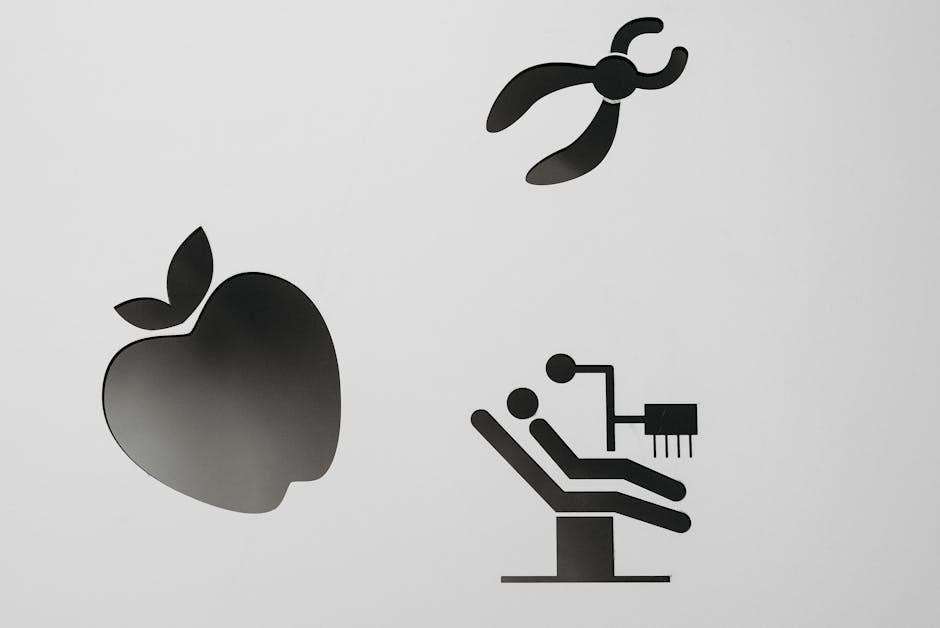
- Smoking and tobacco use are prohibited.
- Alcohol consumption should be avoided.
Physical Rest
Rest is crucial after tooth extraction to ensure proper healing. Avoid strenuous activities, bending, or heavy lifting for 24 hours. Lying down or reclining can help reduce swelling. Refrain from smoking or using tobacco products, as they delay recovery. Alcohol consumption should also be avoided during the initial healing phase. Limit physical exertion to prevent dislodging the blood clot. Light activities, such as reading or watching TV, are acceptable. Ensure adequate sleep to support your body’s recovery process. Avoid any actions that may put pressure on the surgical site or interfere with healing.
Avoiding Strenuous Exercise
Avoid strenuous exercise for 24-48 hours after tooth extraction to prevent complications. Activities like heavy lifting, bending, or intense workouts can dislodge the blood clot, delaying healing. Refrain from smoking or using tobacco products, as they impair recovery. Avoid alcohol consumption during the initial healing phase. Resting and limiting physical exertion helps the body recover faster. Light activities, such as walking or reading, are acceptable if they don’t cause discomfort. Ensure adequate sleep to support healing. Avoid any actions that may put pressure on the surgical site or interfere with the healing process.
Smoking and Tobacco Use
Smoking and tobacco use should be avoided for at least 24-48 hours after tooth extraction. Smoking can delay healing, reduce blood flow, and increase the risk of complications. Tobacco products, including chewing tobacco, can dislodge the blood clot, leading to dry socket. Avoid exposure to secondhand smoke as well. Smoking can also introduce bacteria into the surgical site, increasing infection risk. To promote healing, refrain from all tobacco products during the initial recovery period. Your dentist may recommend avoiding smoking for a longer duration depending on your specific case. Quitting or reducing tobacco use supports faster recovery and overall oral health.
Alcohol Consumption
Avoid consuming alcohol for at least 24-48 hours after tooth extraction. Alcohol can interfere with the healing process, dislodge the blood clot, and increase the risk of complications. It can also interact with pain medications, reducing their effectiveness. Drinking alcohol during recovery may lead to dry socket, a painful condition requiring additional treatment. Additionally, alcohol can irritate the surgical site, prolonging recovery and increasing the risk of infection. To ensure proper healing, refrain from alcohol consumption during the initial recovery period. Your dentist may advise avoiding alcohol for a longer duration based on your specific situation.
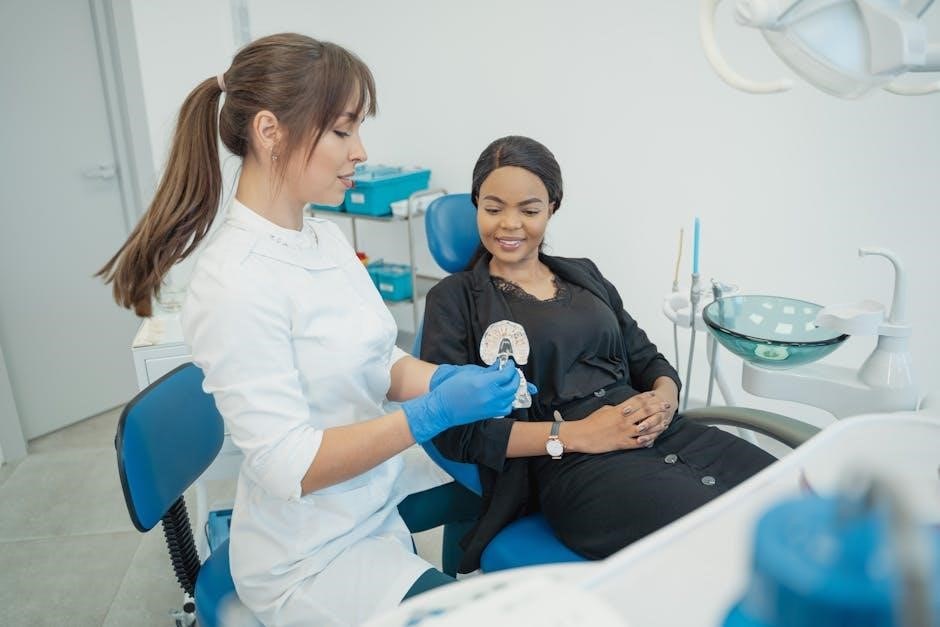
Managing Swelling and Bruising
Apply ice packs to the affected area to reduce swelling. Elevate your head while resting to minimize bruising. Monitor swelling and bruising, as they typically subside within days.
Ice Application
Apply an ice pack to the swollen area for 15-20 minutes, repeating every hour as needed. This helps reduce swelling and bruising. Wrap the ice in a cloth to avoid direct skin contact. Continue this for the first 24 hours post-surgery. Ice application is most effective within the first few hours after extraction. Ensure the ice pack is secure and does not move around, allowing consistent cooling to the affected area. This simple step can significantly minimize discomfort and promote faster healing. Always follow your dentist’s specific instructions regarding ice usage.
Elevation of the Head
Elevate your head using extra pillows to reduce swelling and discomfort. Keep your head above heart level, ideally at a 30-45 degree angle. Avoid bending over or lying flat. This helps minimize swelling and promotes healing. Continue elevating your head for the first 24 hours post-surgery. If swelling increases, maintain elevation consistently. This simple step can significantly reduce post-operative discomfort and aid in faster recovery. Always follow your dentist’s specific instructions regarding head elevation to ensure optimal healing outcomes.
Monitoring Swelling
Monitor swelling by observing the affected area for redness, puffiness, or increased size. Mild swelling is normal after tooth extraction and typically subsides within 24-48 hours. Use ice packs as directed to reduce swelling. Track changes in size and color, noting if swelling worsens or persists. If swelling becomes severe or is accompanied by pain, contact your dentist immediately. Keep your head elevated to help reduce swelling. Avoid touching or pressing on the swollen area, as this can cause discomfort or delay healing. Regularly assess the swelling to ensure it is improving and not a sign of complications.

Bruising Care
Bruising after tooth extraction is common and usually temporary. To care for bruises, avoid strenuous activities that may worsen discoloration. Apply ice packs to affected areas to reduce bruising. Gently massage the area with a soft cloth if discomfort arises. Monitor bruising for signs of infection, such as increased redness or warmth. If bruising persists or darkens significantly, contact your dentist. Keep the head elevated to minimize blood flow to the area. Avoid rubbing or pressing on bruises, as this can delay healing. Most bruises fade within a week, but if concerns arise, seek professional advice.
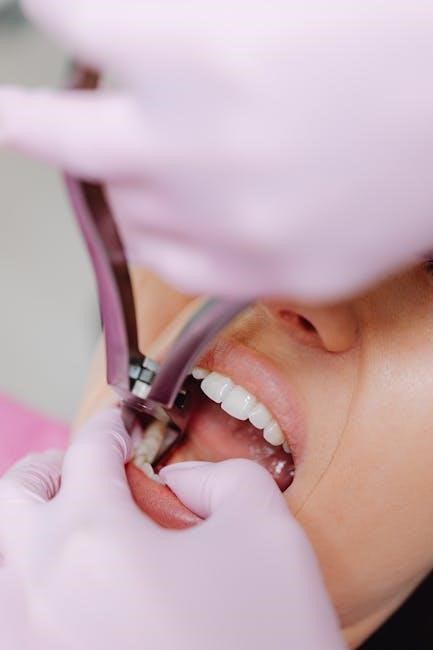
Follow-Up Care
Attend scheduled appointments for suture removal and healing progress checks. Monitor the surgical site for proper recovery and adjust your bite as directed by your dentist.
Suture Removal
Sutures are typically removed 7-10 days after surgery, depending on the healing progress. Attend your scheduled appointment for safe removal by your dentist. Avoid disturbing the sutures beforehand, as this can delay healing. After removal, maintain good oral hygiene and follow post-operative instructions to ensure proper recovery. Your dentist will monitor the healing process and provide guidance on any necessary adjustments. Keep the area clean to prevent infection and promote tissue repair. Suture removal is a quick procedure, and any discomfort is usually minimal and temporary.
- Do not pull or cut sutures yourself.
- Attend all follow-up appointments as directed.
Post-Operative Check-Ups
Regular follow-up appointments are crucial for monitoring healing progress after tooth extraction. Attend all scheduled visits to ensure proper recovery and address any concerns. Your dentist will assess the surgical site for signs of infection, swelling, or delayed healing. These check-ups also allow for suture removal and bite adjustment if necessary. Be prepared to discuss any symptoms or discomfort experienced during recovery. Adhering to your dentist’s recommendations ensures optimal healing and minimizes complications. Keep all appointments to maintain a smooth and successful recovery process.
- Inform your dentist of any unusual symptoms during visits.
- Follow all post-operative instructions provided during check-ups.
Healing Progress Monitoring
Monitor the surgical site daily for signs of proper healing, such as reduced swelling and the formation of a blood clot. Keep the area clean to prevent infection. Attend follow-up appointments to allow your dentist to assess healing progress. Note any unusual symptoms, such as increased pain or swelling, and report them promptly. Avoid disturbing the extraction site with your tongue or fingers to ensure uninterrupted recovery. Proper healing typically takes 1-2 weeks, but this may vary depending on the complexity of the procedure.
- Watch for signs of infection, such as redness or pus.
- Ensure the area remains dry and free from contaminants.
Adjusting Your Bite
After tooth extraction, avoid chewing hard foods or biting forcefully to prevent disrupting the healing process. Stick to a soft diet for the first few days and chew on the opposite side of the mouth. Attend follow-up appointments to ensure proper healing and bite alignment. If you notice any changes in your bite or difficulty chewing, inform your dentist promptly. Avoid smoking or consuming alcohol, as these can interfere with healing and bite adjustment. Proper bite adjustment is crucial for restoring normal chewing function and preventing further complications.
- Soft foods like yogurt and mashed potatoes are recommended.
- Avoid hard or crunchy foods for at least a week.
- Follow-up appointments are key for monitoring bite alignment.

Infection Prevention
Keep the surgical site clean to prevent infection. Use prescribed antibiotics as directed and maintain good oral hygiene. Monitor for signs of infection, such as redness or swelling.
- Avoid contaminants like smoking or unclean foods.
- Rinse with salt water to reduce bacteria.
- Watch for increased pain or pus formation.
Signs of Infection
Monitor for signs of infection, such as increased pain, swelling, redness, or pus around the surgical site. Fever, chills, or a bad taste in the mouth may also indicate infection.
- Excessive bleeding that doesn’t stop with pressure.
- Swollen lymph nodes or difficulty opening the mouth.
- Yellow or thick discharge from the extraction site.
- Prolonged healing or worsening symptoms.
Contact your dentist immediately if these symptoms occur to prevent complications.
Antibiotic Usage
Take prescribed antibiotics exactly as directed to prevent infection. Complete the full course, even if symptoms improve. Avoid alcohol and smoking, as they can interfere with healing and antibiotic effectiveness.
- If side effects like nausea or rash occur, consult your dentist.
- Antibiotics may interact with other medications, so inform your dentist of all prescriptions.
- Do not stop antibiotics early, as this can lead to incomplete infection treatment.
Adhering to antibiotic instructions ensures proper healing and reduces infection risks after tooth extraction.
Maintaining Oral Hygiene
Proper oral hygiene is crucial for healing after tooth extraction. Gently brush teeth with a soft-bristle toothbrush, avoiding the surgical site. Rinse with warm salt water (1 teaspoon salt in 8 ounces of water) 2-3 times daily, starting 24 hours post-op.
- Avoid using harsh mouthwashes or abrasive toothpaste near the extraction area.
- Resume normal brushing and flossing for other teeth to maintain overall oral health.
- Keep the mouth clean to prevent infection and promote healing.
By following these steps, you can ensure a clean environment for proper recovery and minimize complications.
Avoiding Contaminants
To prevent infection, avoid introducing contaminants near the surgical site. Refrain from smoking or using smokeless tobacco products for at least 24 hours post-extraction. Do not consume alcohol or carbonated beverages, as they can dislodge the blood clot and delay healing.
- Steer clear of spicy or sharp foods that might irritate the area.
- Do not rinse vigorously or use a straw, as suction can disrupt the healing process.
- Keep the extraction site clean by avoiding contact with dirty hands or contaminated objects.
By minimizing exposure to contaminants, you reduce the risk of complications and support a smooth recovery.
General Recovery Tips
Ensure proper rest, avoid strenuous activities, and maintain a clean environment to promote healing. Monitor your progress and follow all instructions provided by your dentist.
- Avoid smoking and alcohol for 24 hours post-extraction.
- Keep the surgical site clean to prevent infection.
- Stay hydrated and eat soft, nutritious foods.
Recovery Timeline
Recovery after tooth extraction typically follows a predictable timeline. Initial healing occurs within the first 24 hours, with swelling peaking around 24-48 hours post-procedure. By day 3-4, swelling subsides, and the surgical site begins to granulate. Full soft tissue healing usually takes 1-2 weeks, while bone healing may take several months. Patients should avoid strenuous activities during the first week to prevent complications. Monitoring progress and adhering to post-operative instructions ensures optimal healing. Mild discomfort and bruising are normal but should diminish gradually. If unusual symptoms persist, consult your dentist promptly to address any concerns.
Emotional Well-Being
Emotional well-being is crucial during recovery. Patients may feel anxious or overwhelmed, but maintaining a calm and positive mindset aids healing. Engage in relaxing activities like reading or listening to music to distract from discomfort. A supportive environment with family or friends can uplift spirits. Ensure adequate rest to reduce stress and promote emotional balance. If feelings of anxiety persist, consider deep breathing exercises or meditation. It’s important to acknowledge emotional needs and seek help if necessary. A positive attitude and focus on recovery can significantly improve overall well-being during this period.
Sleep Positioning
Proper sleep positioning is essential for recovery. Elevate your head using extra pillows to reduce swelling and promote healing. Avoid lying flat or sleeping on the side of the extraction site, as this can dislodge the blood clot. Sleep on your back with your head slightly elevated to minimize discomfort and prevent bleeding. If necessary, use a supportive pillow to maintain this position. Avoid sudden movements or turning sharply, as this can disrupt the healing process. A comfortable and stable sleep position will help ensure a smooth recovery and reduce the risk of complications.
Overall Health Monitoring
Monitor your overall health closely after tooth extraction. Watch for signs of infection, such as increased pain, swelling, redness, or fever. Note any unusual bleeding or discharge. Ensure proper nutrition by eating soft, nutrient-rich foods to support healing. Stay hydrated to prevent dehydration, which can slow recovery. Avoid smoking and alcohol, as they impede healing and increase infection risk. If you experience severe symptoms or discomfort, contact your dentist promptly. Regularly assess your recovery progress and adjust your activities accordingly to avoid complications. Maintaining good overall health will significantly aid in a smooth and effective recovery process.
